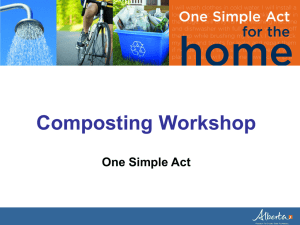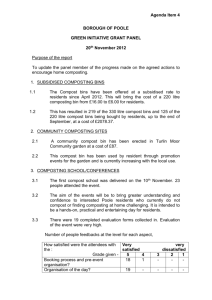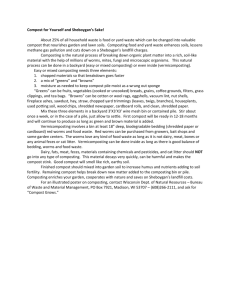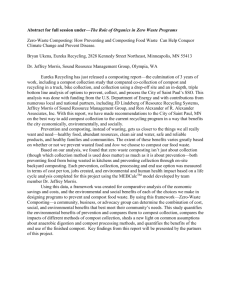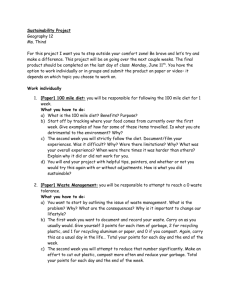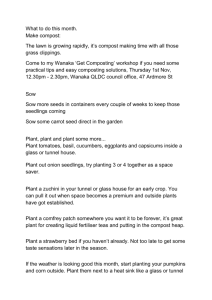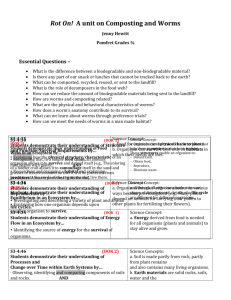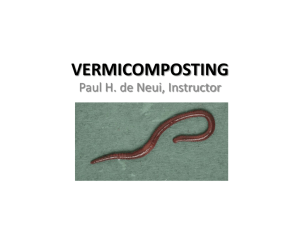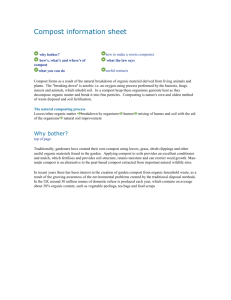Environmentally Friendly Practices at Home
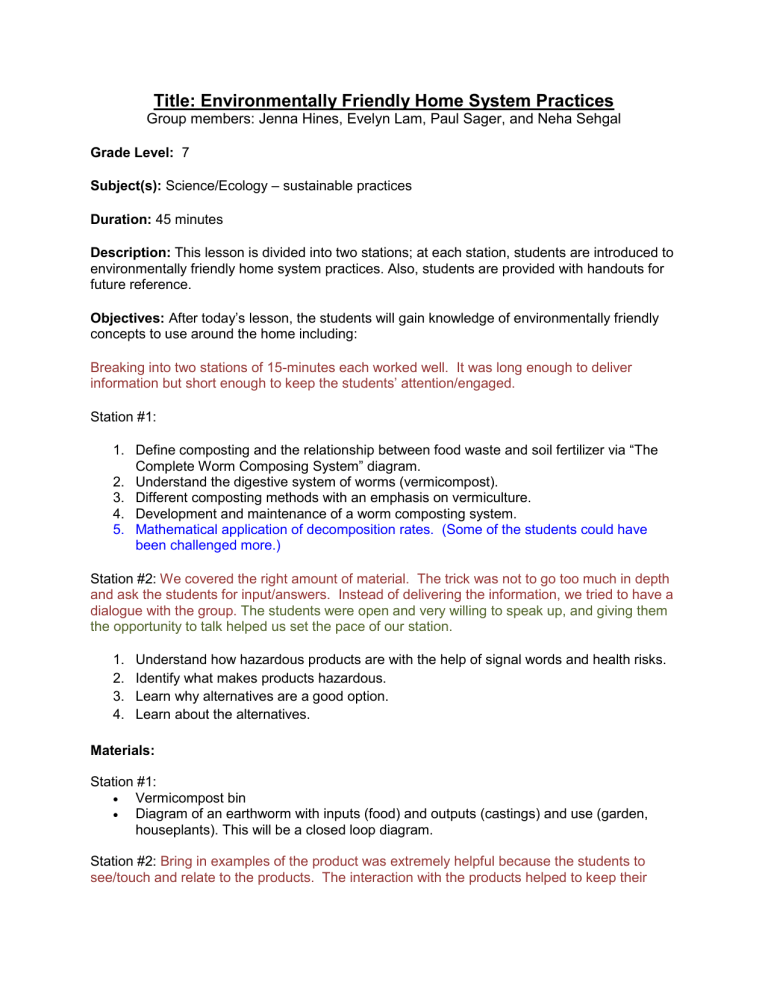
Title: Environmentally Friendly Home System Practices
Group members: Jenna Hines, Evelyn Lam, Paul Sager, and Neha Sehgal
Grade Level: 7
Subject(s): Science/Ecology – sustainable practices
Duration: 45 minutes
Description: This lesson is divided into two stations; at each station, students are introduced to environmentally friendly home system practices. Also, students are provided with handouts for future reference.
Objectives: After today’s lesson, the students will gain knowledge of environmentally friendly concepts to use around the home including:
Breaking into two stations of 15-minutes each worked well. It was long enough to deliver information but short enough to keep the students’ attention/engaged.
Station #1:
1. Define composting and the relation ship between food waste and soil fertilizer via “The
Complete Worm Composing System” diagram.
2. Understand the digestive system of worms (vermicompost).
3. Different composting methods with an emphasis on vermiculture.
4. Development and maintenance of a worm composting system.
5. Mathematical application of decomposition rates. (Some of the students could have been challenged more.)
Station #2: We covered the right amount of material. The trick was not to go too much in depth and ask the students for input/answers. Instead of delivering the information, we tried to have a dialogue with the group. The students were open and very willing to speak up, and giving them the opportunity to talk helped us set the pace of our station.
1. Understand how hazardous products are with the help of signal words and health risks.
2. Identify what makes products hazardous.
3. Learn why alternatives are a good option.
4. Learn about the alternatives.
Materials:
Station #1:
Vermicompost bin
Diagram of an earthworm with inputs (food) and outputs (castings) and use (garden, houseplants). This will be a closed loop diagram.
Station #2: Bring in examples of the product was extremely helpful because the students to see/touch and relate to the products. The interaction with the products helped to keep their
attention ; the models also acted as grounding points when the students’ focus drifted vaguely in the direction of some tangential comment.
Vinegar, baking soda, Borax, alternative brands
Environmentally-friendly home practice worksheet
Examples of sustainable and non-sustainable cleaning products
Closing
Dirt pudding: instant chocolate pudding, Oreos, gummy worms, cups, and spoons.
(Do not prepare the pudding on the playground during recess time – don’t even be outside in view during recess – awkward questions, much screaming, general terror .) Having a tasty treat for the students was great. It helped us get on their “good” side and kept them focused because there was a reward at the end.
Vocabulary:
Station #1:
1. Compost – A mixture of decayed or decaying organic matter used to fertilize soil.
Compost is usually made by gathering plant material (such as leaves, grass clippings, vegetables, fruits) and some animal byproducts (dairy) into a pile or bin and letting it decompose as a result of the action of aerobic bacteria, fungi, and other organisms.
2. Vermicompost – is the end-product of the breakdown of organic matter by some species of earthworm. Vermicompost is a nutrient-rich, natural fertilizer and soil conditioner.
.
Station #2: The vocabulary was introduced to the group during the station. Also, we provided handouts for the students, so they could look over it/share with their parents after the workshop.
[The handouts served as a summation of our main points with a little extra material that we didn’t have time to cover. It was reassuring to know that the students walked away from our stations with something concrete in their hands that could help them remember what we talked about.] We tried to keep the vocabulary simple and steered away from jargon. Also, we did a
“where is the word on the product” search activity to help the students understand the vocabulary and where to look for it when they go to the store with their parents.
1. Hazardous products – corrosive, flammable, reactive, or toxic ingredients
2. Signal words
– Caution, warning, danger
3. Toxicity – measure of how harmful a substance is
4. Bioaccumulation – an increase in the concentration of a chemical in specific organs or tissues at a level higher than would normally be expected
Detailed Agenda:
Introduction (5 min.): Introduce who we are and what we are going to talk about. Divide the class into 2 groups and bring them to the appropriate station. Being outside helped a
lot [having outdoor stations was both our idea and one of t he teacher’s suggestions for what he would like for his class] . It was critical for us to be energetic and seem passionate about what we were talking about to set the tone. We quickly told the students what was planned for them and then broke them into two smaller groups. It was easier to engage the students in the smaller groups ; splitting the class created a more casual environment with less pressure on us to “perform.”
Activities (total 30 minutes): Two rotations, each 15 minutes long. o Station 1: (15 min.)
Compost (3-5 minutes)
Question students about home composting experience.
What is composting?
Converting organic matter into nutrients that can be used for fertilizer.
Why would anyone want to compost?
Open discussion and understanding of the purpose and benefits of composting:
reducing garbage that would otherwise go to a landfill
reduce the energy it takes for someone to come pick up your garbage and take it somewhere else
Reduces dependence on chemical additives by making your own fertilizer and subsequently save money and energy.
Explain the different types of composting and that we will be focusing on vermicomposting.
Vermicompost (7-12 minutes)
Refer to diagram. o What types of things can you put in the compost bin? o What things should not be put in the bin? o What happens when you put the food in? o How does the bin work? o What types of worms can you use? o How much food does a worm eat? o Why do we use the castings? o What can we do with the castings? o How do you get the compost from your bin to your garden?
Screens, plastic sheets.
o What is the reproduction rate of worms? And how do the reproduce?
Propose a word problem: Cindy has two types of compost of equal size.
One contains only dirt while the other contains worms. On Monday morning she puts 8lbs of food in her worm compost, containing .4lbs of worms. It takes until Friday night for the food to decompose. She puts
1lb of food into her soil compost on Wednesday morning and it only takes until Thursday night for the food to decompose. Which compost bin decomposes food faster and what are the rates of decomposition
(lbs/day)?
The worm compost is faster with a rate of 1.6lbs/day while the rate of decomposition for the dirt compost is only .5lbs/day
Station assessment: Ask student how they can take these environmentally friendly concepts home with them. What are some of the
challenges they will face? (Many good questions were asked and the students were participatory throughout the lesson.) o Station 2: (15 minutes) – detailed agenda
Station agenda:
1-2 minutes: Welcome to activity and settle in
2-8 minutes: Information delivery – go over main objectives (*see handout for the main points that will be covered) o Objectives 1 and 3 – Neha I prepared a lot of material for this section but did not use most of it. I liked presenting in an impromptu manner and going with the dynamics of the group. It worked well for me. o Objectives 2 and 4 – Evelyn [Preparing more material than what was used worked well, especially since they already learned a couple of these concepts in class. Having more information allowed for flexibility to keep the teaching fresh and interesting.]
8-13 minutes: Group activity – break class into two groups and have the groups answer sit in a circle in two teams and answer questions; the team with the most correct answers gets 1-2 extra credit points Instead of this activity we had questions/answer time mixed in with the activity; we tried to continuously keep the students engaged by asking them to explain what they knew and then we built off of that. This way the time went by faster. Again, being energetic and having a dialogue with the students (instead of lecturing at them) worked like a charm. They liked it, and it made us more comfortable with what we were doing. It likely would have been difficult to sufficiently teach and then organize this activity because of the brevity of the class period.
13-15 minutes: Q&A/debriefing/handouts with main points
Students asked their questions during the presentation; this was easier to do.
Station assessment:
The game’s questions/answers will gauge how well the students have learned and retained the material. Additionally, we will have verbal assessments during the debriefing (i.e. what will to tell your parents about composing and sustainable practice). We gauged success by looking at how engaged the students were and what they talked about with their peers. Most of the students really liked the activity. We intentionally did not have a “worksheet” or paper/pencil activity because that is something the students do daily, and it would have detracted from the real practicality of what we wanted to convey . The hands-on experience was different but very enjoyable for the students.
Closing (5 min.): Regroup the stations and reflect on the workshop (ask what they liked and why).
The closing was a chance for all the facilitators to quickly debrief on the stations and then ask the students what they are going to take away from the stations.
This helped us evaluate what they learned and will retain. All the students/staff were provided with 2-3 handouts, if they were curious about the topic and wanted to learn more.

